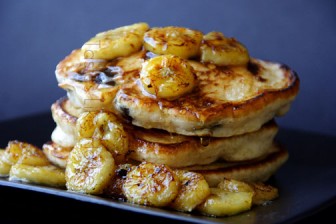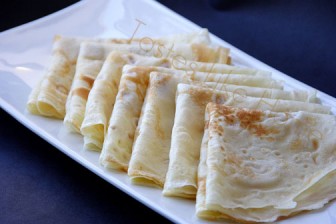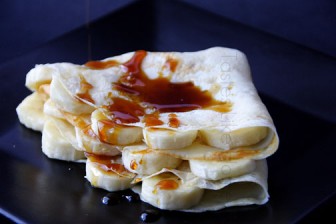Hi Everyone,
After all the pancake-talk last week, did you make any? You know, as a trial run. I did. Oh come on, don’t judge me, I had to; I did it for you so that I am better informed to communicate with you about pancakes (laugh).
This week I’ll wrap up the 2-part pancake series with the big day looming – Shrove Tuesday. I want to give you another pancake option – the French crêpe. And, I want to share with you some things that you can add to your regular pancakes to make them even more special.
Crêpes
 A crêpe is a very thin pancake. The word itself is French in origin, deriving from the Latin crispa, meaning ‘curled’. This popular type of pancake originated in Brittany, a region in the northwest of France and it is considered a national dish. However, it is not only the French who make and enjoy crêpes, many other countries throughout Europe make a version of this thin pancake. It is very popular now in North America too. While it has not completely wowed us here in the Caribbean, yet, one can find crêpes on many menus at upscale restaurants in the region.
A crêpe is a very thin pancake. The word itself is French in origin, deriving from the Latin crispa, meaning ‘curled’. This popular type of pancake originated in Brittany, a region in the northwest of France and it is considered a national dish. However, it is not only the French who make and enjoy crêpes, many other countries throughout Europe make a version of this thin pancake. It is very popular now in North America too. While it has not completely wowed us here in the Caribbean, yet, one can find crêpes on many menus at upscale restaurants in the region.

Unlike the traditional North American style pancake, the crêpe is lauded for its thinness, it flexibility and its capacity to have a multitude of fillings enveloped within its folds. The batter for crêpes is watery as opposed to the dropping consistency that is necessary for the more traditional pancake. And the one other major difference is that the crêpes are not made with any chemical leavening agents – baking powder, baking soda. The eggs in the batter provide all the structure that is needed to make the crêpes pliable and delicate.
Crêpes are versatile in that you can alter the batter to make crêpes to use with sweet fillings or to serve as is with powered sugar (icing sugar) or your favourite syrup. Or they can have savoury fillings such as eggs, ham, cheese, sautéed spinach, mushrooms etc.
Making crêpes is a little trickier than making regular pancakes but once you get the hang of it, you’ll find it easy. There are several points to note that once followed, will always take you to crêpe land.
The batter

The batter has to be very thin, almost watery; it must run off of the spoon or whisk immediately, leaving an ever so light trace. Once the batter is mixed, leave it to rest at room temperature for at least an hour. This resting period is necessary as it allows the batter to settle and will aid in the crêpes not tearing during cooking.
The pan
A really good non-stick pan works great. Please don’t waste your money and go buying a crêpe pan. It is not necessary. If you already have one then fine but don’t go buying one.
The grease
Oil is your best option. Use a neutral tasting oil such as Canola, Vegetable or Peanut oil. Remember butter burns easily when heated but if you prefer to use butter, then do so.
Cooking the crêpes
Give the batter a few whisks before you start making the crêpes, as you will notice that it has settled with the top looking golden. Now, the amount of batter that you will put into the pan will be determined by the size of your pan. I have a standard-size 8-inch non-stick pan that I use to make my crêpes, I pour in ¼-cup of batter (3 tablespoons/1.5 fluid oz). If your pan is let’s say 6 inches, then pour in 2 tablespoons (1 fluid oz) of batter.
Remember I told you how to measure your pans? Take a ruler or tape measure and measure across the bottom of the pan and that will determine the size of your pan.
Add a couple drops of oil to the pan and heat it on medium heat. This will always vary depending on the size of your burner. You want consistent heat but not high heat. If you use a high heat then your crêpes will burn easily.

Always pour the batter into the center of the pan and then swirl the pan to spread the batter evenly. What this means is that you should lift the pan off of the stove once you’ve poured the batter in, in order to swirl it around. If you do not do this, then you run the risk of the batter not spreading as thinly as it should. What I do is to remove the pan from the heat altogether, pour in the batter, swirl it around the pan and then return it to the heat to cook. Of course, I’ve made more than just a few crêpes so I am comfortable doing this, but I promise that you’ll get the hang of it too. Practice. Don’t worry if the first two crêpes don’t turn out perfectly. It’s all going one place right?
You’ll know when to turn the crêpes because you’ll see tiny little holes on top or around the edges or if you shake the pan and see and feel the pancake moving then its time to flip it. Use a flat plastic spatula to flip it. The pros toss the crêpe into the air to flip it. I am no pro.
A crêpe should not take more than 1 minute to cook in total time.
Stacking
Insert a 4-inch piece of wax paper between each crêpe, as they are finished cooking and stacking. This prevents them steaming up and sticking to each other.
When you are ready to serve the crêpes, you fold them in half and then again in half to make a triangle; serve as is, with a dusting of powdered sugar, a drizzle of honey or syrup. Or, you can slather it with some jam, marmalade or any fruit preserve; fresh fruit, peanut butter or really, anything you like. Fold it or roll it up and tuck in.
Serving pancakes
Last week, we talked about fillings/stuffing that you can have with your regular pancakes such as fruit, grated pumpkin, chocolate chips etc. In addition to those fillings, there are other things that you can serve with your pancakes – a generous dusting of powdered sugar, honey, homemade syrup, maple syrup, chocolate syrup, condensed milk and caramel are just some of the decadent things you are drizzle over your pancakes. Whipped cream, fruit compote, stewed guavas; jams and any kind of fruit preserve will work well. Or, you can sauté or grill some fruit and serve it warm with the pancakes. One of my favourites is sautéed bananas. Look, the fact is that you can serve it with whatever pleases and delights you.
Whichever pancakes you make this Tuesday – the fried doughnut-like ones (Malasadas), the regular flat pancakes or French crêpes, have fun making them and make a lot so that you can share with your family and friends.
If you’d like the recipe for the fried pancakes, send me an email, as space does not permit me to include it here.
Happy weekend everyone.
Crêpes
Yield: 10
Ingredients
1 cup all purpose flour
2 tablespoons white sugar
A pinch of salt
2 eggs, whisked
1 cup whole milk
1/3 cup water
Oil
Directions
1. Mix together the flour, sugar and salt in a bowl.
2. Add eggs and pour in milk and water and whisk to make smooth thin batter.
3. Cover the batter and set aside for 1 hour at room temperature.
4. When you are ready to cook crêpes, whisk batter.
5. Add 2 drops of oil to non-stick pan and heat over medium heat.
6. Pour batter into the middle of the pan (1/4 cup if using an 8-inch pan, 2 tablespoons if using a 6-inch pan). Lift pan from stove and swirl to spread evenly. Cook for 30 – 45 seconds or until crêpe loosens from pan; flip and cook for 15 seconds. Place on a plate lined with wax paper.
7. Repeat steps 5 and 6 until all the batter is done and insert a 4-inch piece of wax paper between each crepe.
8. Serve as you please.
NOTE
Stir in 1 teaspoon vanilla, lemon or rose essence as an option when you are ready to cook the crêpes.
Flat pancakes
Yield: 4 – 5
Ingredients
1 cup all purpose flour
1 ½ teaspoons baking powder
2 tablespoons white sugar
A pinch of salt
1/8 teaspoon ground cinnamon
1 egg, room temperature, whisked
¾ cup whole milk (substitute with water)
Canola oil
Directions
1. Add flour, baking powder, sugar, salt and cinnamon to a bowl and mix together.
2. Add egg and milk and make a batter of dropping consistency. (Add more milk/water if needed). The batter should not be thin or watery.
3. Rest batter for at least 30 minutes. The longer it rests, the higher the pancakes rise.
4. Add a few drops of oil to a non-stick pan and swirl. Heat on medium heat. If using tawah, let tawah heat up first, then lightly brush with oil.
5. Pour 1/3 cup of batter onto pan and swirl using the back of a spoon. Spread out to about 4 inches in circle. Let cook until bubbles or holes start to form. Flip pancakes (do not slam down) and let continue cooking until it comes away easily from the pan. Do not press down on pancakes.
6. Remove cooked pancake and place on paper towels. Repeat steps # 4 and 5 until all the batter is used up. Insert a piece of wax paper between each pancake.
7. Pancakes can be kept warm in a 200 degrees F oven while you continue making the others.
Variations
● Add chocolate chips, fresh or dried fruit to batter just as you are getting ready to cook the pancakes.
● To sauté bananas, add a pat of butter to a pan and heat, add sliced bananas and sauté until it stars to caramelize. Serve immediately.
Cynthia
Cynthia@tasteslikehome.org
www.tasteslikehome.org









